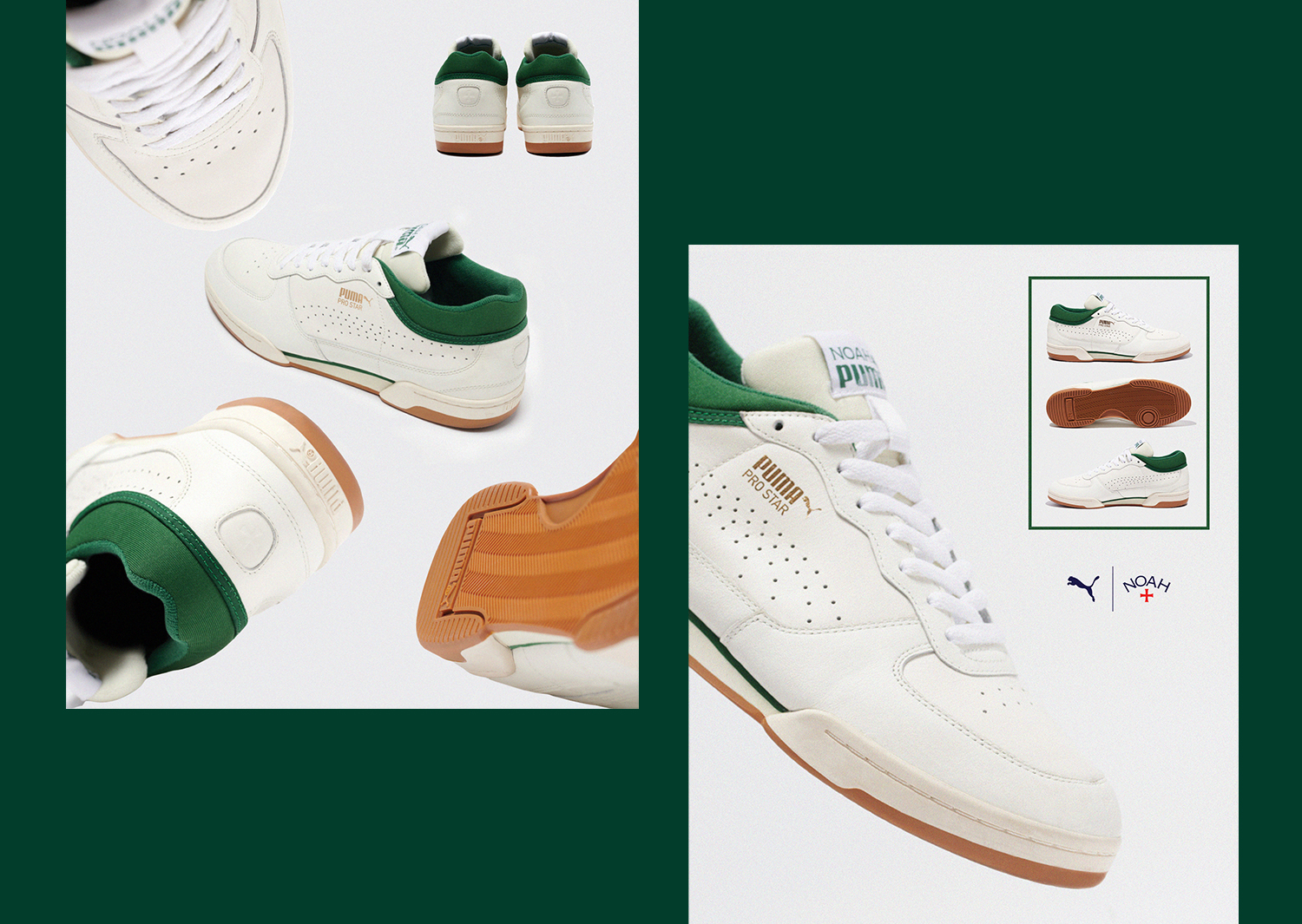By Tim Newcomb
The Evolution of On-Court Tennis Shoes
When tennis players from the 19th century hiked up their trousers, they showed off something that has fascinated fans for well over 100 years: tennis shoes. But just as those trousers and corset-layered dresses gave way to short shorts, the tennis skirt, and even a bodysuit here and there (yeah, we’re talking Serena Williams and Puma-crafted kits), the tennis shoe took on an evolution like no other sneaker has seen.
About 150 years of history will do that.
To get from the street style of the mid-1800s to the court style of the 21st century required the sport to modernize, both in design and technology. Some shoes best epitomized that shift and set new standards for the sport. We explore that journey here, dipping into history, nostalgia, and hot lava to highlight the tennis shoe, the most fascinating sneaker style in sports.
Tennis Shoes Earn Their Name
The late 1800s brought the first technological advancement in the world of tennis shoes: the plimsoll. A plimsoll shoe features Charles Goodyear’s development of vulcanized rubber combined with a canvas upper. This creation allowed for more comfortable movement in one of the most popular sports of the day. As the plimsoll grew in acceptance on the tennis court, it also found many a use outside the sport, but folks knew of its roots. It was, after all, a tennis shoe.
While the 1800s and early 1900s still had their fair share of men wearing the all-leather loafers popular at the time—as well as women in heeled boots and some players adding spikes to the leather for grip—the mass production of rubber sneakers really took off in the early 1900s and helped turn a leather fashion into a mix of rubber and canvas by the 1920s.
Switching to canvas and rubber with waffled outsoles, says Antoine Oui, footwear product manager for Wilson, offered a lightweight switch from the heavy leather shoes of the time. It was the first technological and style evolution brought by tennis.
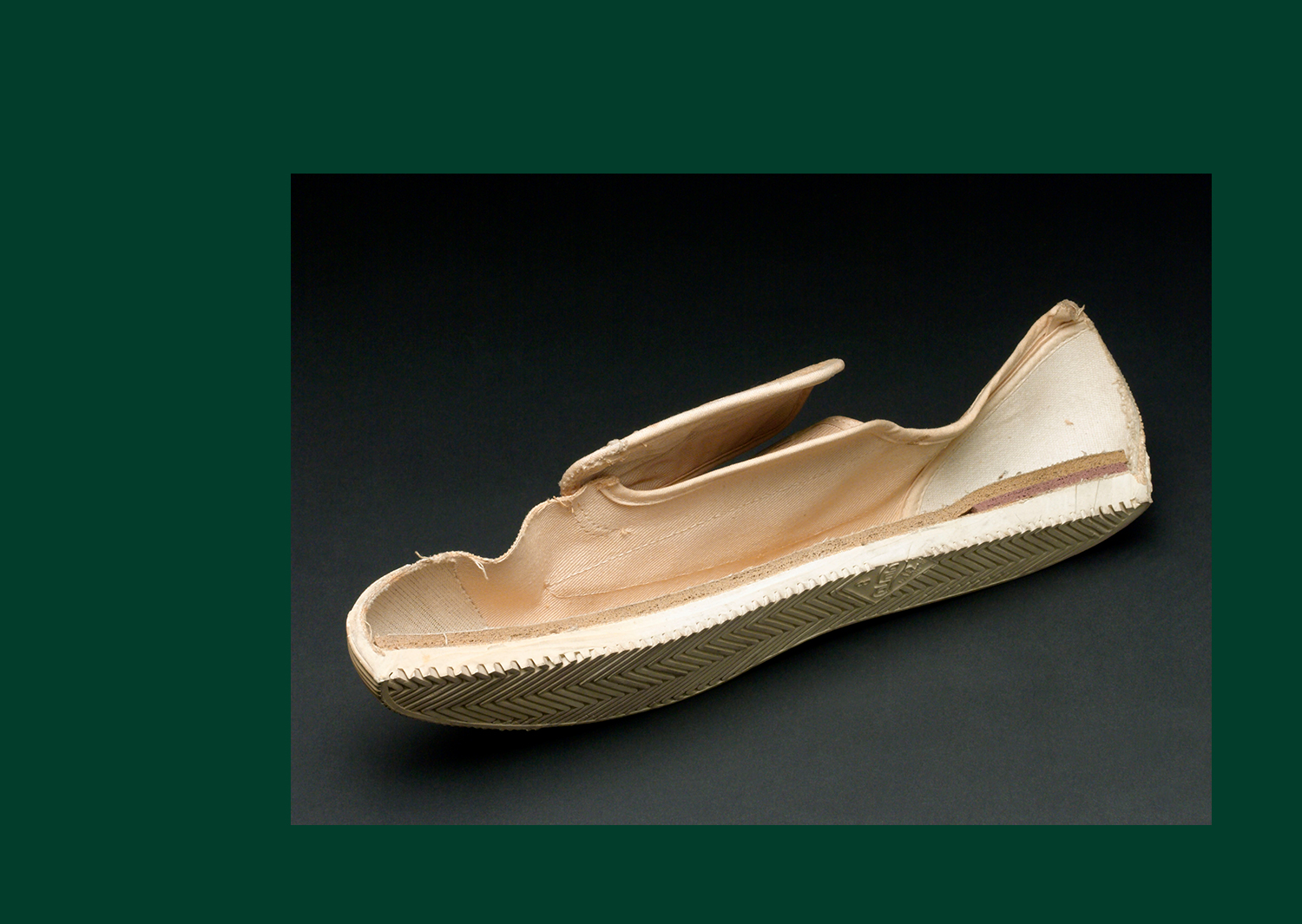
Dunlop plimsoll, sectioned, c 1950s, size 8, with cushioned insole.
(Photo by SSPL/Getty Images)
Give Keds Its Due
If we’re being serious, we don’t want to talk about Keds being a key influencer in the world of tennis shoes. That’s just not as culturally significant as discussing Andre Agassi, Stan Smith, and Serena Williams. Keds, though, were arguably the first universally accepted shoe for tennis when they hit the market in 1916. Created by the United States Rubber Company, the rubber-soled Keds kicked off a new era in tennis.
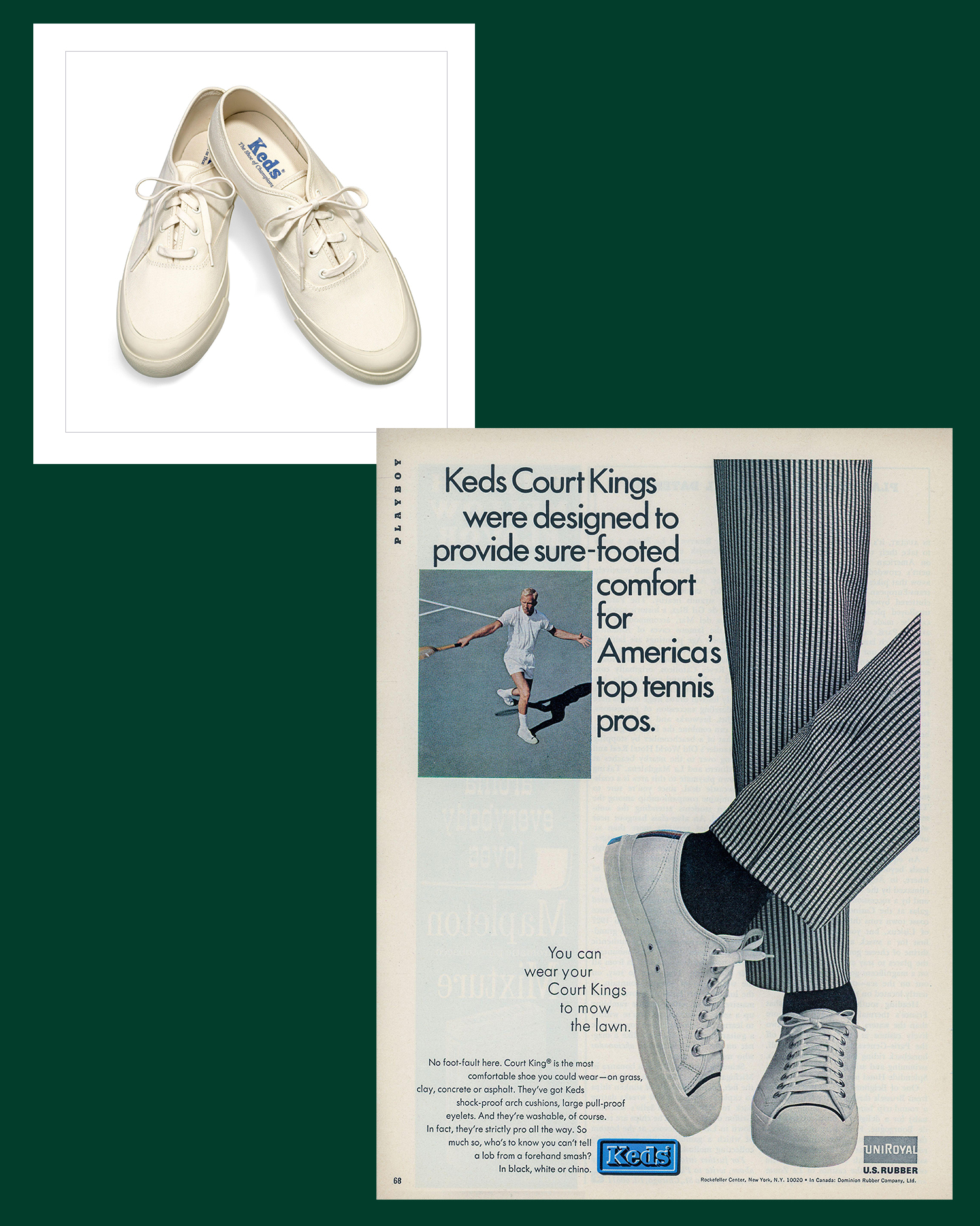
You can wear your Court Kings to mow the Lawn. (Alamy)
Just one year later, Converse—which started as the Converse Rubber Shoe Company and had begun to focus on athletic shoes—launched the All-Star, making Keds and Converse two of the most popular tennis shoes in the world. Add in Adidas marketing the first shoe specifically for the sport in 1931, and tennis was already starting to heat up the rubber and canvas game.
Don't Forget Jack
As rubber companies doubled as sneaker companies, the B.F. Goodrich Company of Canada partnered with badminton star Jack Purcell to create a signature shoe for the sport in 1935. What was good for badminton was apparently good for tennis, and the Jack Purcell sneaker became a mainstay in worldwide tennis.
Rubber companies continued to provide canvas and rubber offerings in the ensuing decades, all without a wealth of variety. Converse remained popular, while Australian players heavily favored Dunlop (also a rubber company) with the brand’s Green Flash and Volley designs. The Jack Purcell rounded out the crop of main shoes in the game.
Stan Smith once told me that even into the 1960s, most players outside Australia were wearing either Converse or Jack Purcells. “There wasn’t a big choice,” he says. “I don’t remember people thinking about shoes too much.”
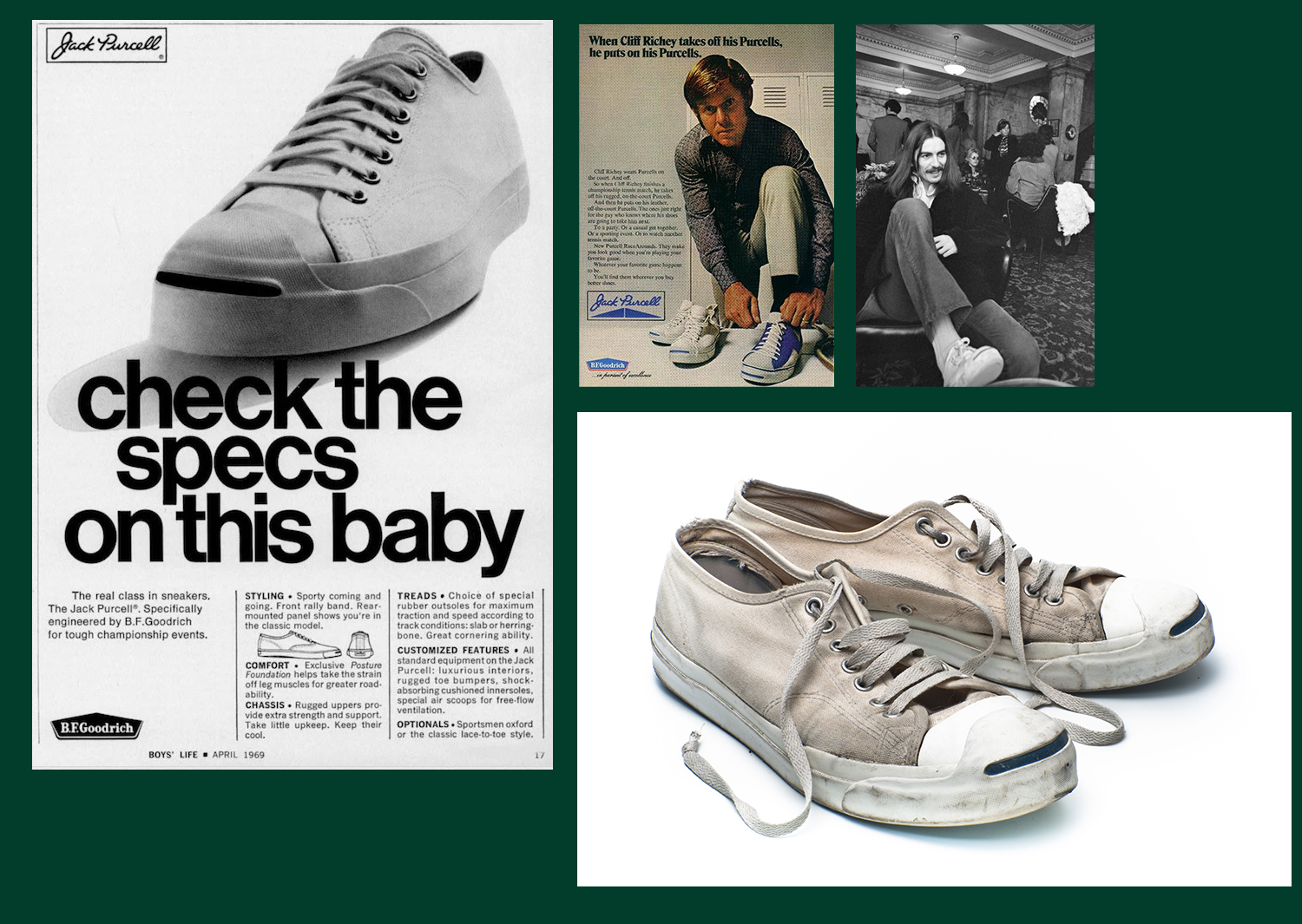
Check the specs on this baby; Purcell pitchman Cliff Richey; George Harrison was a big Jack Purcell guy (Getty); a pair of well-worn Jack Purcells. (Alamy)
Adidas Shifts the Shoe Game
Canvas had its day. Okay, canvas actually had multiple decades. But Adidas decided to really kick tennis shoes into a modern era in the 1960s. The German footwear company introduced leather to the sport with a Robert Haillet-endorsed shoe in 1964. For those in the know, when Haillet retired, American Stan Smith became the literal face on the shoe, and the Stan Smith is easily the brand’s top-selling sneaker of all time.
“It was the only shoe out there at the time [with leather], and it already had a bit of a following and was fairly unique in tennis,” Smith once told me about being approached to lead the endorsement of what was the Haillet. “It took a little bit of time [to get used to it], but it was pretty comfortable.”
The leather upper first introduced in the 1960s didn’t change much in the ’70s under Smith, although he led the way for more protection around the Achilles—that’s why we have a color tab on the back of the shoe—and a tongue that didn’t shift.
Another key design of the day, the Adidas Rod Laver, offered up a polyurethane outsole for durability—Smith jokes that Laver preferred wearing the Stan Smith when he played on clay because the rubber had better traction than the durable polyurethane—and paired it with suede and mesh to really accentuate the use of fresh materials.
“Athletes wore those [Stan Smiths and Rod Lavers] because they had superior traction, they had leather uppers,” Josh Wilder, New Balance tennis product manager, tells me. “They were stable for the time and for the athletes. For me, that’s where [tennis shoe evolution] starts.”
Once Adidas joined the leather world, it wasn’t long before other brands followed. The K-Swiss Classic, Puma Match, Nike Wimbledon, and others grew more popular by offering leather.
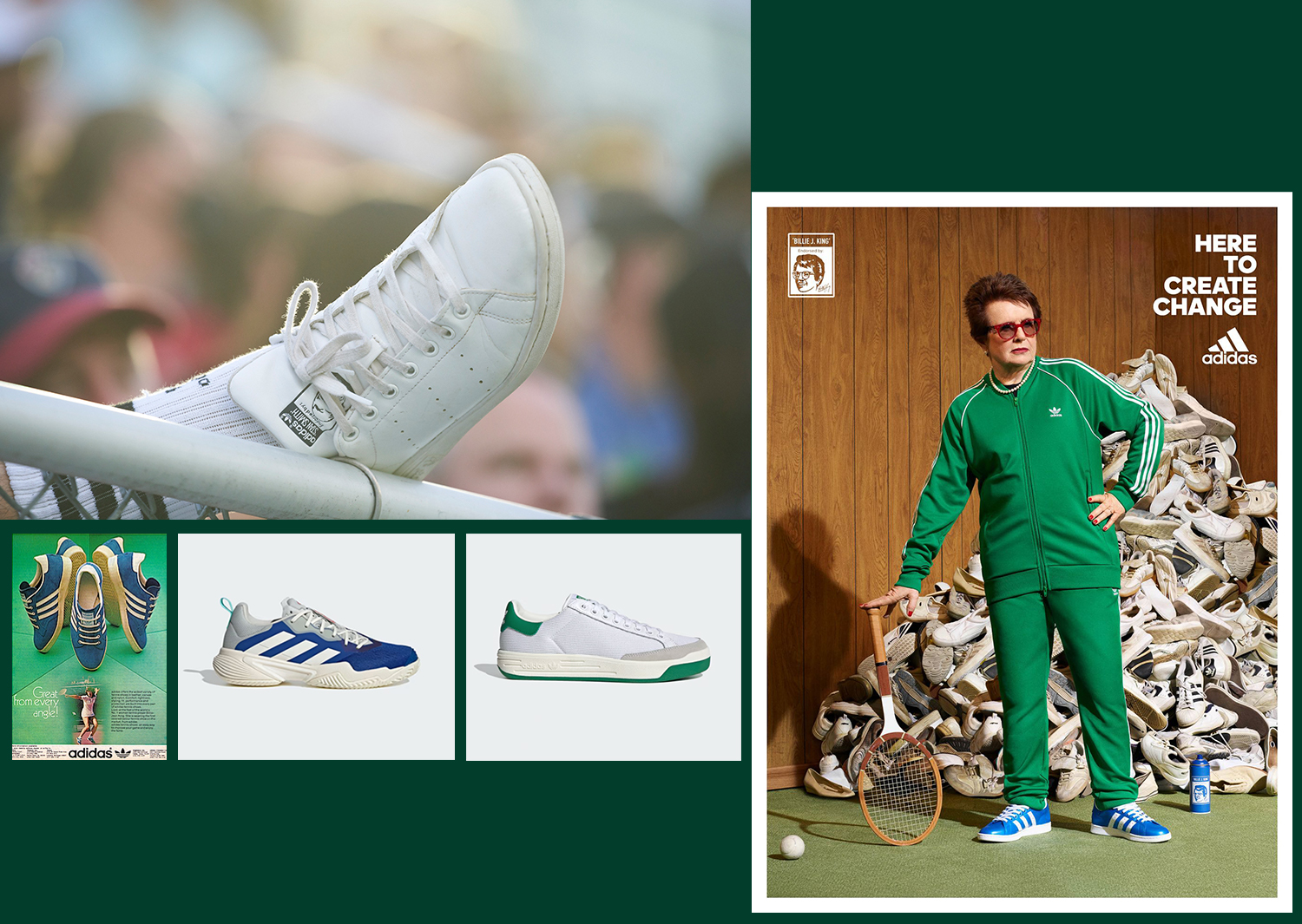
Billie Jean King’s signature shoe, 1974; Stan Smiths, perfect for every occasion. (Matthew Salacuse); Adidas' brand-new Barricade, in Billie Jean King colorway. (Adidas)
Puma’s Boris Becker design from 1985 offered up an early look at an athlete working closely with a brand, says Ulrich Planer, Puma archive senior manager. The Becker mid-top design was chosen to limit ankle rolling and “encourage more risk-taking on the court.”
The rubber cupsole design became the industry standard on the outsole by the 1980s. That started with the Stan Smith, but it also took over basketball and tennis from Nike’s Air Jordan 1 and Air Force 1 in basketball to tennis shoes such as Adidas’ Nastase and Lendl Comp models, the Wilson Pro Staff, and key Converse designs.
“These shoes designed for action sports have now become icons of the sneaker industry,” Oui says, adding that they still hold powerful style sway today. “Consumers love them because they carry a strong heritage, and all these sports brands were able to market them in a way to create consumer demand with very well-executed storytelling.”
Adidas offered up another first in 1974: a signature shoe for a female. The Billie Jean King silhouette emerged in royal blue, giving color to a sport steeped in plenty of white. Not only did King have the first signature shoe for a female in any sport, but it opened a path for other females in the tennis world to land deals. This year, Adidas launched a version of its Barricade in King’s signature colorway.
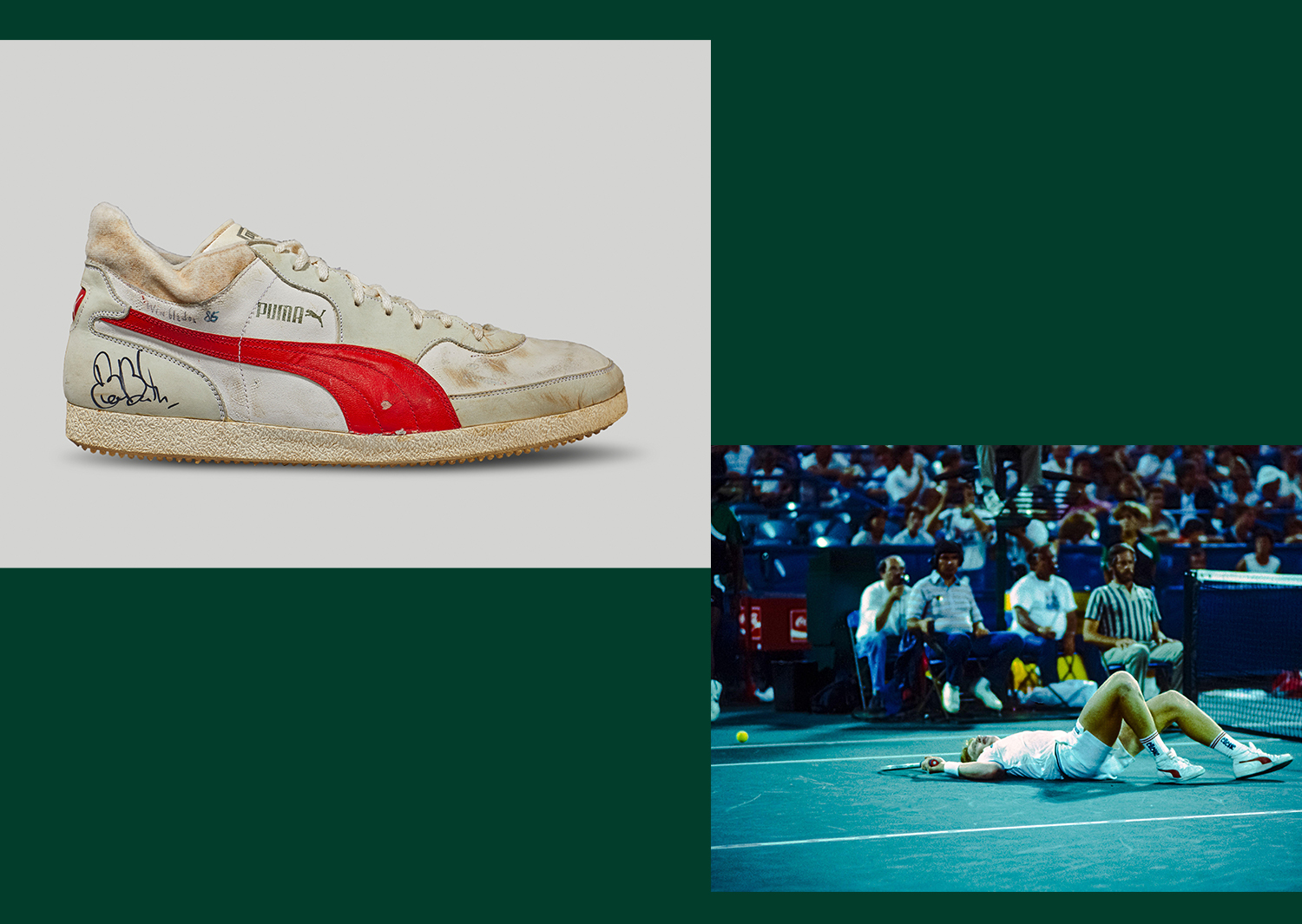
Puma’s Boris Becker design from 1985 offered up an early look at an athlete working closely with a brand. (Puma)
Nike’s Air Trainer 1 Changes Tennis
Famed Nike shoe designer Tinker Hatfield didn’t go about aiming to completely revolutionize the tennis sneaker. But he did it anyway, with the Nike Air Trainer 1 in the late 1980s.
As the name suggests, he designed the shoe as the first-ever cross-training silhouette, meant to give folks heading to the gym the ability to wear one shoe for all their activities instead of needing different shoes for varying workouts. While working with John McEnroe on a new design following the Mac Attack, Hatfield sent him a pair to try out.
“By chance, when the guys at Nike sent me a bunch of different prototypes to try, there was this throwaway one that they weren’t even planning on sending me,” McEnroe once said. “And it turned out being the one, to me, that was the most awesome. Once they were on, I was like, ‘Sorry, guys, this is the one. We have to go with this, we have to reverse field here.’ This one felt really right.”
The shoe hadn’t been released yet, but McEnroe started wearing them in tournaments, and Nike even gave him versions for grass and clay. The lateral support in the Nike Air Trainer 1, along with the mid-cut stability and lock-down feel, really shifted course for the industry.
Wilder says a tennis explosion of thinking outside the box in terms of shoe construction started with the Air Trainer 1.
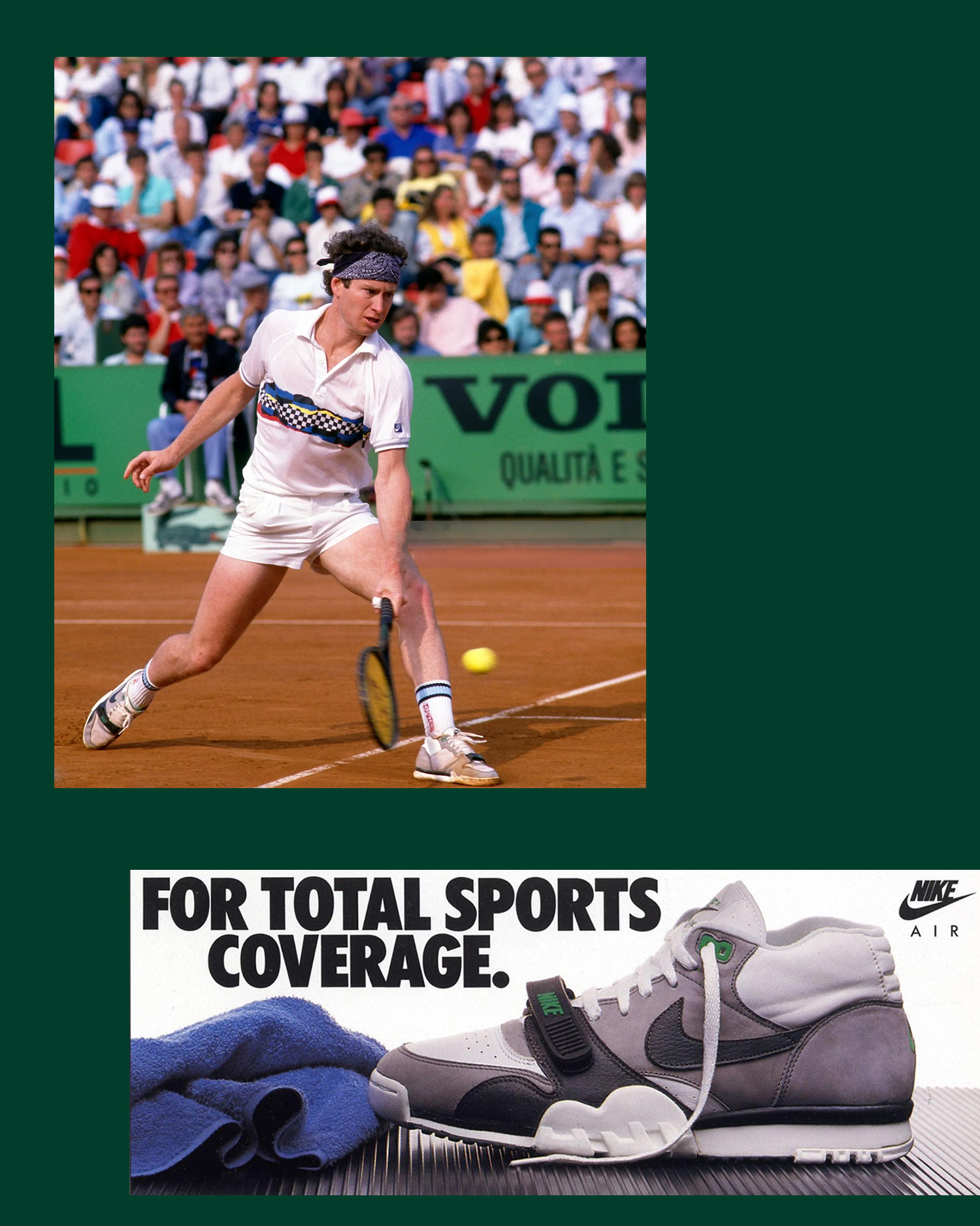
The Nike Air Trainer 1. “By chance, when the guys at Nike sent me a bunch of different prototypes to try, there was this throwaway one that they weren’t even planning on sending me,” McEnroe once said.
As Bo Jackson knows, the Air Trainer 1 went on to become more famous outside tennis, even as Hatfield and Nike started creating specifically for the sport.
“John turned the Air Trainer into a tennis shoe, even though it was made as a cross-trainer shoe,” Mike Nakajima, who spent three decades at Nike, mostly as the director for tennis sports marketing, tells me. “The shoe really encompasses the ability to play multiple sports in one shoe.”
Andrew Ng, founder of Sneaker Preservation Society with a focus on Nike tennis archiving, tells me the Air Trainer 1 was the shoe that really changed the game. “Without the Air Trainer 1,” he says, “I don’t think we have the Air Tech Challenge and the Air Tech Challenge 2.”
Hot Lava, Agassi, and the Nike Air Tech Challenge 2
McEnroe and Agassi may have worn the Air Trainer 1, but arguably the most famous true tennis shoe of the era was the Nike Air Tech Challenge 2. Crafted by Hatfield with Agassi in mind when the Hot Lava colorway debuted in 1990, it took on both a style and technology step forward.
The Air Tech Challenge 2 offered up a three-quarter height upper and combined everything from a more lightweight synthetic leather and a molded heel counter to additional padding and a midfoot saddle. Most noticeable, though, was the first-ever visible air bubble in tennis history. The materials and cushioning were next-level.
Still, it was the design that really turned heads. The white, pink, and black French Open Hot Lava colorway made famous during Roland-Garros (Agassi actually first wore that design at Indian Wells) has lived on in not only tennis culture but sports culture as one of the most impactful shoe designs in history.
“I look back at that time and the collection as the start of a beautiful thing,” Agassi once told me. “It was, again, real and authentic, but it was also an exploration, one that felt like a continuation and process that was only going to evolve and morph. People felt the freedom to let it be what it needed to be.”
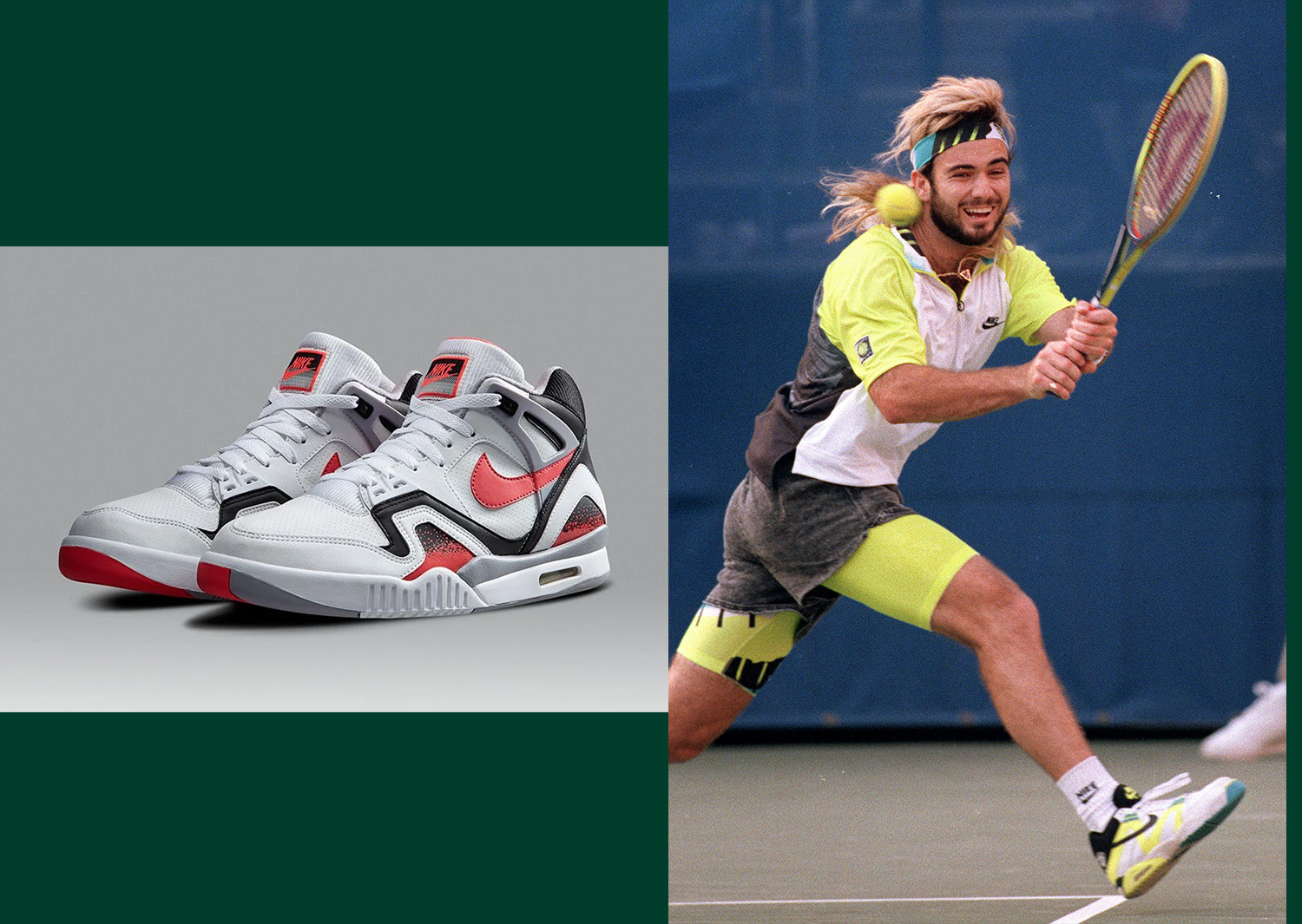
Andre Agassi’s Nike Air Tech Challenge 2, arguably the most famous true tennis shoe of its era (Nike); Andre makes lemonade in the Air Tech Challenge 3. (AP)
Ng calls the Hot Lava version of the Air Tech Challenge 2 one of the top five shoes of all time, in any sport, right alongside the Air Trainer 1 and Air Jordans. He adds that since the Air Trainer 1 wasn’t really designed or marketed as a tennis shoe, the Air Tech Challenge 2 was also the design that shaped a fresh approach to marketing (think Agassi and McEnroe).
“That was the point,” he says, “where they said, ‘Let’s take something special in Andre and capitalize on it,’ and they really played off his personality.”
The Merging of Style and Performance
Agassi and Nike made the combination of style and performance a must-have in tennis shoes. But they weren’t the only ones in the game.
Puma had its own key moments. The GV Special for Guillermo Villas and the Puma Cell worn by Serena Williams both blended technology with a distinct style (and while not truly a shoe moment, Puma’s on-court kits for Williams—with sneakers to match—were some of the best in tennis history).
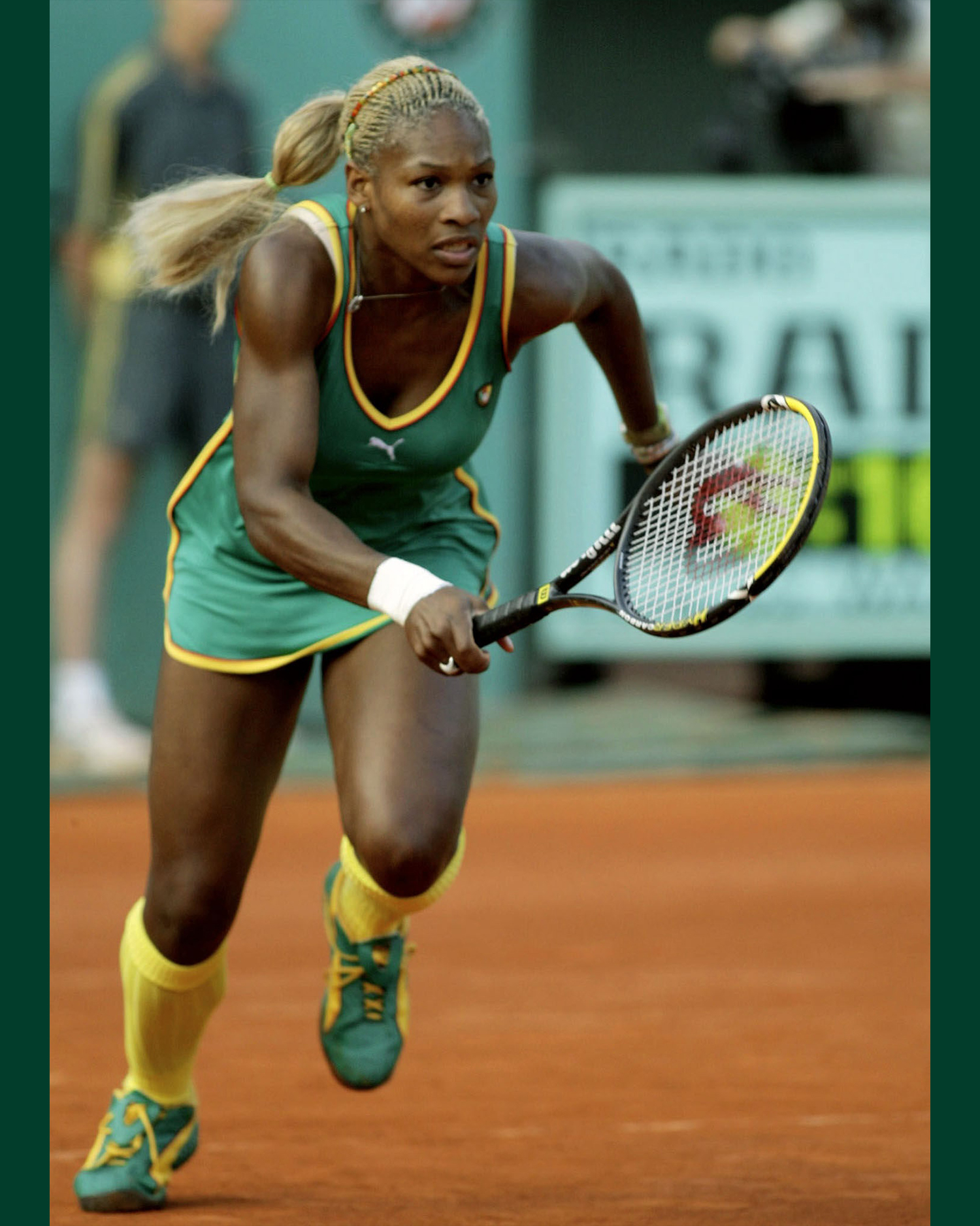
Serena in her iconic Cameroon Puma kit, Roland-Garros, 2002. (Getty)
Diadora offered up the Borg Elite in the 1980s, part of a truly unique take on design. Even Reebok entered the fray, with the fresh Pump technology spliced with basketball design in the Court Victory Pump, worn by Michael Chang in 1990.
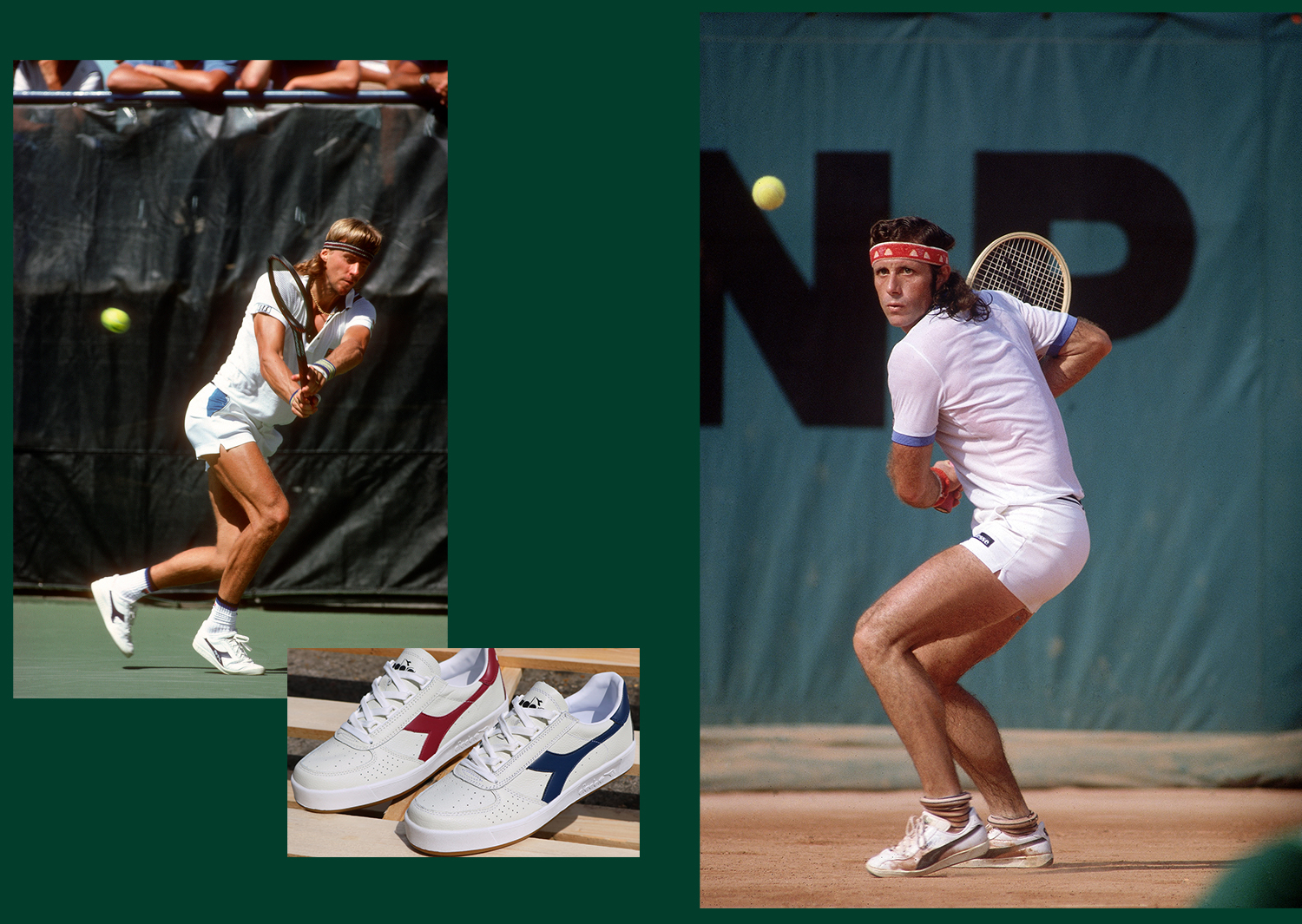
Diadora offered up the Borg Elite in the 1980s, part of a truly unique take on design. (Diadora); Guillermo Villas gets his GV Specials dirty. (Getty)
We’ve seen brands embrace decades of design with lifestyle releases of the once tech-forward and design-focused releases of the ’80s, ’90s, and beyond. From the rereleases from brands like Diadora and Fila to K-Swiss and Puma, which partnered with Noah to recently reimagine archival tennis footwear designs such as the Puma x Noah Pro Star, the tie to nostalgia remains strong.
Materials Matter
The technology takeover kept moving from the late 1980s into the 1990s and beyond. Adidas was easily part of the mix. Its Edberg signature shoes were some of the most technologically forward in the ’90s, bringing the Torsion system underfoot for lateral stability on a low-top. At the same time, Adidas focused on style, mixing fresh colors of the day on the Edberg designs for some of the best-looking and best-playing shoes to rival the Nike offerings.
The influence of non-tennis sports began to push performance levels in tennis. Hatfield told me that when he started designing tennis shoes, he felt the technology had dropped below the level Nike was putting into basketball. Wilder says he believes basketball and running helped clear a path for tennis to start thinking about how to use different materials.
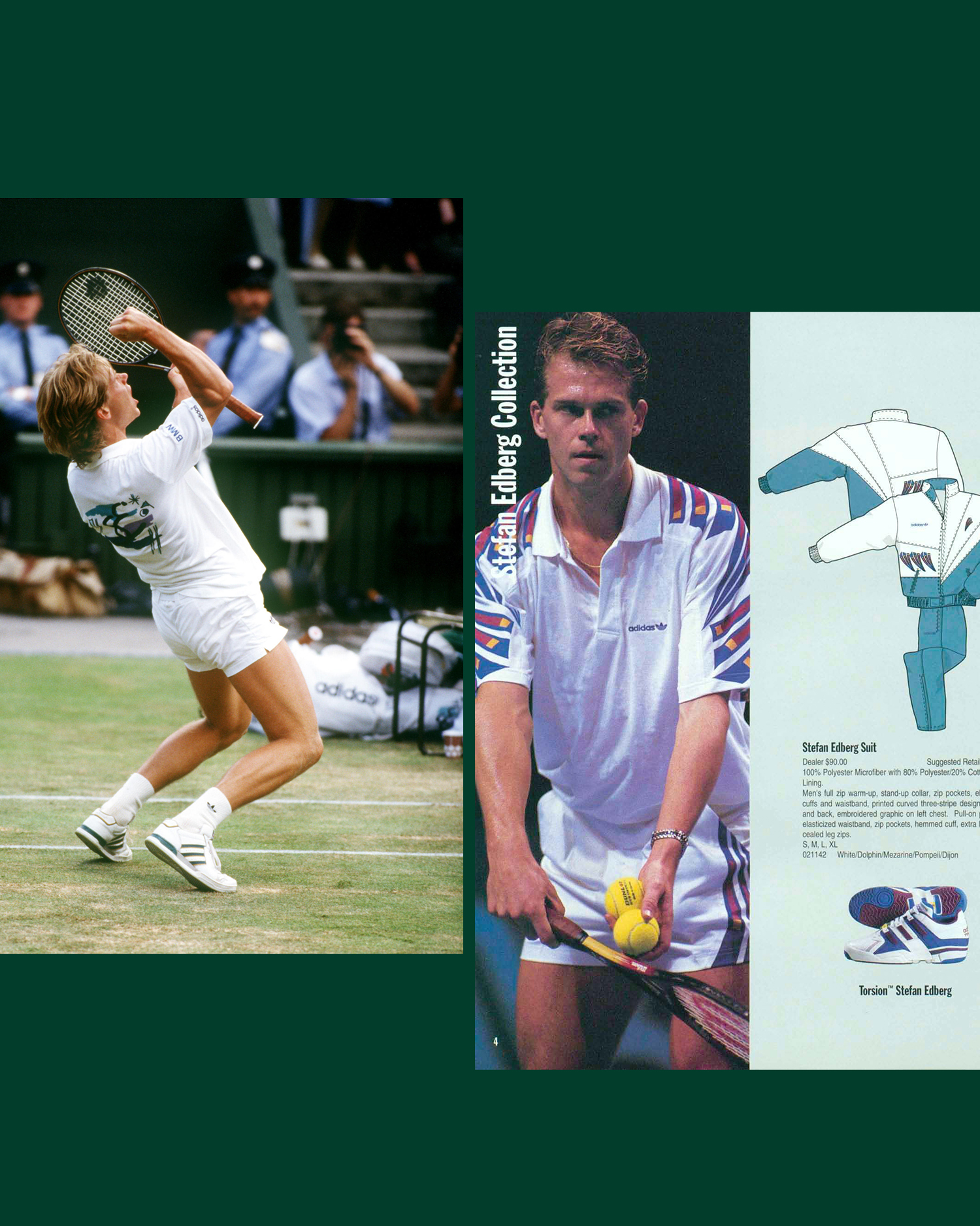
Stefan Edberg debuts the Adidas “Torsion” system. (Getty)
According to Wilder, the move into mesh, woven, and knit materials offered stability and durability while being more breathable and lightweight than leather. “That paved the way for brands to really focus in on the tech and make the athletes better,” he says. “Athletes today are moving way harder and way faster, and they are way stronger than the athletes way back when. We have to have new materials that live up to that standard.”
According to Oui, in the ’90s shock absorption became the goal, with foams, gels, and air the main solutions. In the 2000s, the durability factor built out many tennis shoes, but they became stiff and uncomfortable. The need for comfortable, durable shoes led to a new wave of materials, Oui adds, something that continues to serve as the focus today.
“The future is promising as many brands are seeking solutions to enhance performance in comfort,” he says. “New materials are tested, and the sustainable aspect is taking a part in it too.”
Running With Roger
The technological shift in tennis continued in the 2000s, when the focus eventually moved to slimming down the designs. Again, Hatfield led the way. His Vapor 9 Tour launched in 2012 after he worked with Roger Federer on a new perspective for the sport and a shift for the line that initially debuted in 2004. The two met in a Paris hotel room and Federer told Hatfield he wanted something more akin to a running shoe. Hatfield made it happen.
The “fingers” on the upper of the Vapor design were intended to provide the stability needed in a tennis shoe, but with the weight reduction reminiscent of a running design. “That was the shoe we cracked the code with,” Hatfield once told me, adding it could be the most underrated tennis shoe of all time.
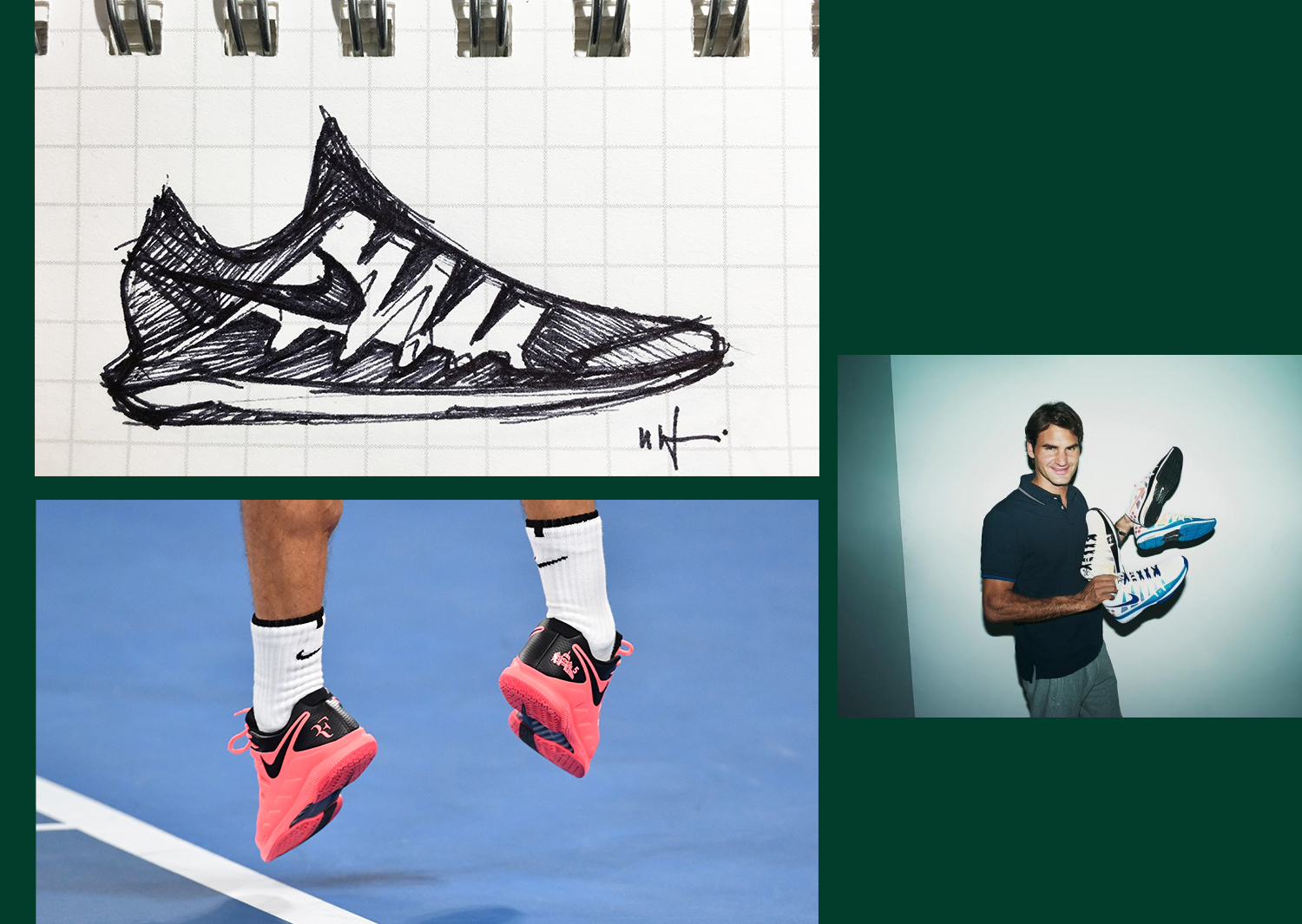
The technological shift in tennis continued in the 2000s when the focus eventually shifted to slimming down the designs. A sketch of the Vapor X (Nike); Roger “Lava Glow” Vapor Xs, worn at the Australian Open, 2018. (Getty)
“It became a great-looking shoe,” Federer once told me, “and I felt it was a new beginning for tennis shoes.”
Nakajima says the brand’s focus on creating a shoe tailored to a star athlete’s tastes led to designs such as the Air Tech Challenge 2 and the Vapor. Ng added that, without input from on-court notables, we wouldn’t have some of his personal favorites, such as the Air Challenge Huarache or the Air Challenge LWP. Crafting fresh approaches year after year for the likes of Agassi and Federer led to shoes athletes wanted and consumers craved.
A Signature Return of Style and Tech
While signature styles once ruled the day in the burgeoning onslaught of tennis shoes in the 1970s and 1980s, their heyday had given way by the late ’90s. Then, in 2022, New Balance made a dramatic investment in the sport with the New Balance Coco CG1 signature model for teenager Coco Gauff.
Not only did the brand play up the basketball-inspired colorway launch calendar, but they also gave the tennis consumer the opportunity to enjoy carbon fiber—something generally reserved for the player-only models—in their tennis shoes.
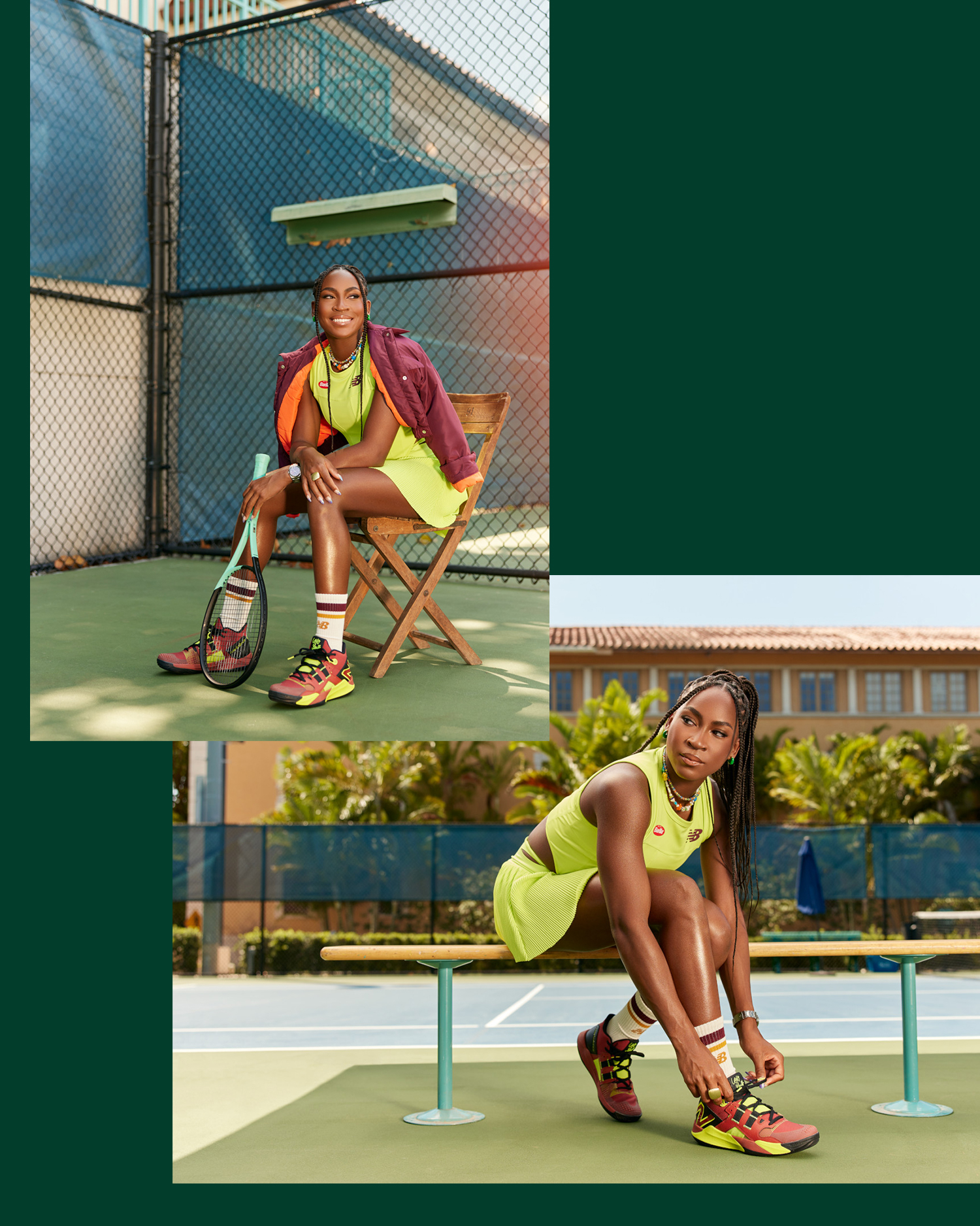
In 2022, New Balance made a dramatic investment in the sport with the Coco CG1 signature model for teenager Coco Gauff. (New Balance)
“Now we are getting to an era where a lot of players have signature shoes outside of tennis,” Wilder says. “Consumers love that level of storytelling to support the athlete. There is a new level of personalization. A new level of storytelling and technology has gotten to a point where it is more readily accessible.”
The Coco CG1 brings together that storytelling with new lightweight meshes and carbon fiber paired with nods to nostalgia via synthetic leather. The CG1 mixes decades of style and technological advances.
We may no longer see trousers or full-volume dresses on the courts, but we do enjoy the changing styles and technologies of tennis shoes.
When the menswear brand Noah had an opportunity to collaborate with Puma on a shoe they chose to focus on tennis and fuse sport and style to develop a shoe that performs on the court and off the court. The sport of tennis is giving it’s style cues to contemporary design and is seen as a viable option for customers regardless if the shoe will ever make it onto the court.
Tim Newcomb covers tennis style and gear for Racquet. He’s chatted tennis gear with Agassi, Federer, McEnroe, Sampras, Gauff, Hatfield, and many others. Follow his Felt Alley Tennis Instagram account.


